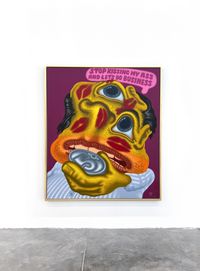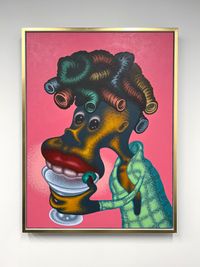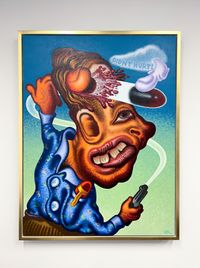Characterised by a corrosive sense of humour and distinctive cartoon style, Peter Saul's drawings and paintings often pair vibrant colours and grossly violent graphic imagery to examine the dark realities of contemporary American culture.
Read MoreUpon graduating from the Washington University School of Fine Arts in 1956, Saul travelled around Europe before settling in Paris. There, he began developing the satirical sensibility that can be seen in the exaggerated lips of Woman in Green Shirt and the dark, beady eyes in Portrait of a Man—two chalk drawings from around 1957. Saul also experimented with blending figuration and Abstract Expressionism, employing dynamic compositions with garish saturated hues and sweeping gestural lines. In Untitled (Lucky Strike) (1960)—crayon, watercolour and collage on paper—a jumbled array of angular abstract forms and recognisable objects such as a telephone, submarine, and speech bubbles are densely packed together.
In the early 1960s, Peter Saul began to incorporate images of commercial products. Pop culture icons are captured in violent and grim scenarios, such as Mickey Mouse surrounded by Japanese war planes in Mickey Mouse vs. the Japs (1962), or Superman sitting in a cell in Superman and Superdog in Jail (1963). The refrigerator is another recurring motif—a sign of luxury and wealth that Saul often has open, revealing unorthodox items inside. In the yellow and green Ice Box 8 (1963), we see a book and a gun with a human figure that has a red bottle as its upper body.
In late 1964, Peter Saul returned to his home city of San Francisco, where he became affiliated with the local Funk art movement. Funk art was made by a loosely associated group of rebellious artists—among them Bruce Conner—whose diverse practices rejected the allure of consumerism and mainstream culture. In 1967, Saul was included in the now-legendary exhibition Funk, curated by Peter Selz at the Powerhouse Gallery of the University Art Museum of the University of California, Berkeley.
In addition to popular culture and figurative abstract expressionism, Peter Saul has built his language from other sources including Surrealism. From the mid-1960s onwards, he has made representations of socio-political moments in contemporary America. Visually convoluted and distorted scenes of state-sanctioned torture and warfare are central to paintings such as Yankee Garbage (1966) and Saigon (1967), while Bush at Abu Ghraib (2006) references American officers' torture and abuse of Abu Ghraib prison detainees. Saul also addressed the civil rights movement of the 1960s (possibly with irony) in The Government of California (1969), in which Ronald Reagan—then the governor of the state—appears as a devil next to Martin Luther King, Jr, depicted with a halo. Other works, such as Subway 1 (1979), with its scene of brutal police violence, still resonate today.
In the 1970s, Saul began deriving inspiration from 19th- and 20th-century masterpieces—an approach he has stuck with. In his Last Moments on the Raft of Medusa (2015), he transformed the dark Romantic painting by Théodore Géricault into a brightly coloured mixture of horror and absurdity.
Saul's selected solo exhibitions include Art History is Wrong, Almine Rech, Paris (2020); Crime and Punishment, New Museum, New York (2020); and Pop, Funk, Bad Painting and More, les Abattoirs, Toulouse (2019). Saul taught at The University of Texas at Austin between 1981 and 2000, influencing younger generations of painters. In 2010, he was elected to the American Academy of Arts and Letters.
Biography by Sherry Paik | Peter Saul | Ocula | 2020






